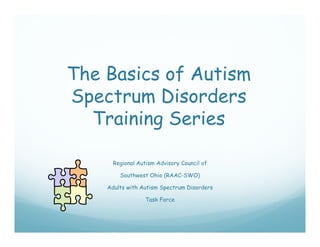Autism 005
- 1. The Basics of Autism Spectrum Disorders Training Series Regional Autism Advisory Council of Southwest Ohio (RAAC-SWO) Adults with Autism Spectrum Disorders Task Force
- 2. Adult Training Series g Modules Module One: Autism Defined, Autism Prevalence and Primary Characteristics Module Two: Physical Characteristics of Autism Module Three: Cognition and Learning in Autism Module Four: Autism and Sensory Differences y Module Five: Communication and Autism
- 3. Adult Training Series g Modules Module Six: Behavior Challenges and Autism Module Seven: Understanding Behavior in Persons with Autism ith A tism Module Eight: Functional Behavior Assessment Module Nine: Autism and Leisure Skills to Teach Module Ten: Special Issues of Adolescence and p Adulthood Ad l h d Module Eleven: Safety and Autism
- 4. Big Idea Communication may be C mm ni ti n m b very difficult for someone with ASD.
- 5. Communication Some people with ASD do not t lk S l ith d t talk They may use sign language to communicate. They may use pictures to communicate. y y p They may use a device that talks for them. Some people with ASD talk but are hard to understand. d t d They may get upset if you don’t understand them.
- 6. Communication mm Some folks with ASD may repeat what you say. If you say, “do you want juice,” they may repeat what you said. This is called Echolalia. This may be their way of saying yes. It might mean that they did not understand what you said. It may happen more often when the person is h f h h nervous or upset.
- 7. Communication Some people with ASD have a hard time making choices. Some people say “yes” to almost every choice yes you give them, even if they don’t want it. Some people say “no” to almost every choice p p y y you give them, even if they want it. Some people almost always choose the last thing you said to them. For example: if you them say, “do you want crackers or cookies,” they may say “cookies” even when they want crackers.
- 8. Big Idea For people who have difficulty making choices, we need to help them by showing them pictures, drawings, pictures drawings logos or the actual items.
- 9. Communication Just b J because the person can say something, it doesn’t h hi i d ’ always mean they understand what they are saying. Just because the person with ASD has done something J st b s th p s ith h sd s m thi before, doesn’t mean that they will be able to understand what is going to happen the next time. People with ASD usually need pictures to help them understand what is going to happen.
- 10. Communication Some people with ASD have trouble p p understanding certain words time words such as “later,” “tomorrow,” “after hil ” “ ft while.” feeling words such as “share” or “be nice.” sayings such as “shake a leg.” shake leg slang words such as “cool.” We have to “watch our language” and make sure the person understands what we are saying. saying
- 11. Communication Tips • Use visuals – such as pictures to help the person understand. • Say things using simple words. y g g p • Don’t talk too fast. • Never talk about behaviors with the person while p they are upset. • Never talk about the person with ASD to someone else, as if th person weren’t there or as if they ls s the s ’t th s th can’t understand what you are saying.
- 12. Big Idea We could be the communication p problem. We need to watch what we say and how we say it.











